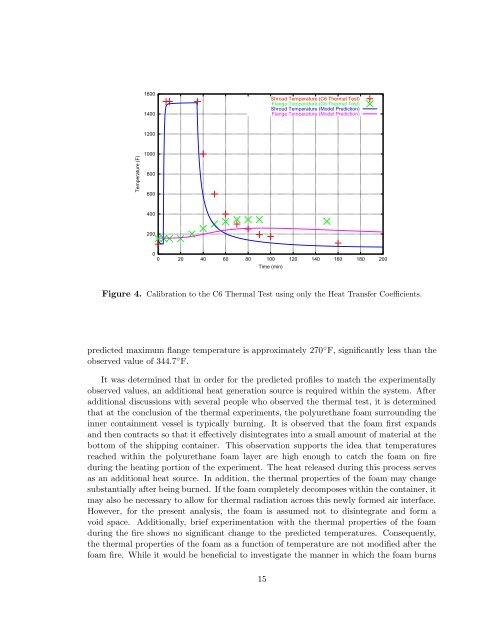Thermal Analysis of a H1616 Shipping Container - prod.sandia.gov ...
Thermal Analysis of a H1616 Shipping Container - prod.sandia.gov ...
Thermal Analysis of a H1616 Shipping Container - prod.sandia.gov ...
Create successful ePaper yourself
Turn your PDF publications into a flip-book with our unique Google optimized e-Paper software.
Temperature (F)<br />
1600<br />
1400<br />
1200<br />
1000<br />
800<br />
600<br />
400<br />
200<br />
Shroud Temperature (C6 <strong>Thermal</strong> Test)<br />
Flange Temperature (C6 <strong>Thermal</strong> Test)<br />
Shroud Temperature (Model Prediction)<br />
Flange Temperature (Model Prediction)<br />
0<br />
0 20 40 60 80 100 120 140 160 180 200<br />
Time (min)<br />
Figure 4. Calibration to the C6 <strong>Thermal</strong> Test using only the Heat Transfer Coefficients.<br />
predicted maximum flange temperature is approximately 270 ◦ F, significantly less than the<br />
observed value <strong>of</strong> 344.7 ◦ F.<br />
It was determined that in order for the predicted pr<strong>of</strong>iles to match the experimentally<br />
observed values, an additional heat generation source is required within the system. After<br />
additional discussions with several people who observed the thermal test, it is determined<br />
that at the conclusion <strong>of</strong> the thermal experiments, the polyurethane foam surrounding the<br />
inner containment vessel is typically burning. It is observed that the foam first expands<br />
and then contracts so that it effectively disintegrates into a small amount <strong>of</strong> material at the<br />
bottom <strong>of</strong> the shipping container. This observation supports the idea that temperatures<br />
reached within the polyurethane foam layer are high enough to catch the foam on fire<br />
during the heating portion <strong>of</strong> the experiment. The heat released during this process serves<br />
as an additional heat source. In addition, the thermal properties <strong>of</strong> the foam may change<br />
substantially after being burned. If the foam completely decomposes within the container, it<br />
may also be necessary to allow for thermal radiation across this newly formed air interface.<br />
However, for the present analysis, the foam is assumed not to disintegrate and form a<br />
void space. Additionally, brief experimentation with the thermal properties <strong>of</strong> the foam<br />
during the fire shows no significant change to the predicted temperatures. Consequently,<br />
the thermal properties <strong>of</strong> the foam as a function <strong>of</strong> temperature are not modified after the<br />
foam fire. While it would be beneficial to investigate the manner in which the foam burns<br />
15
















